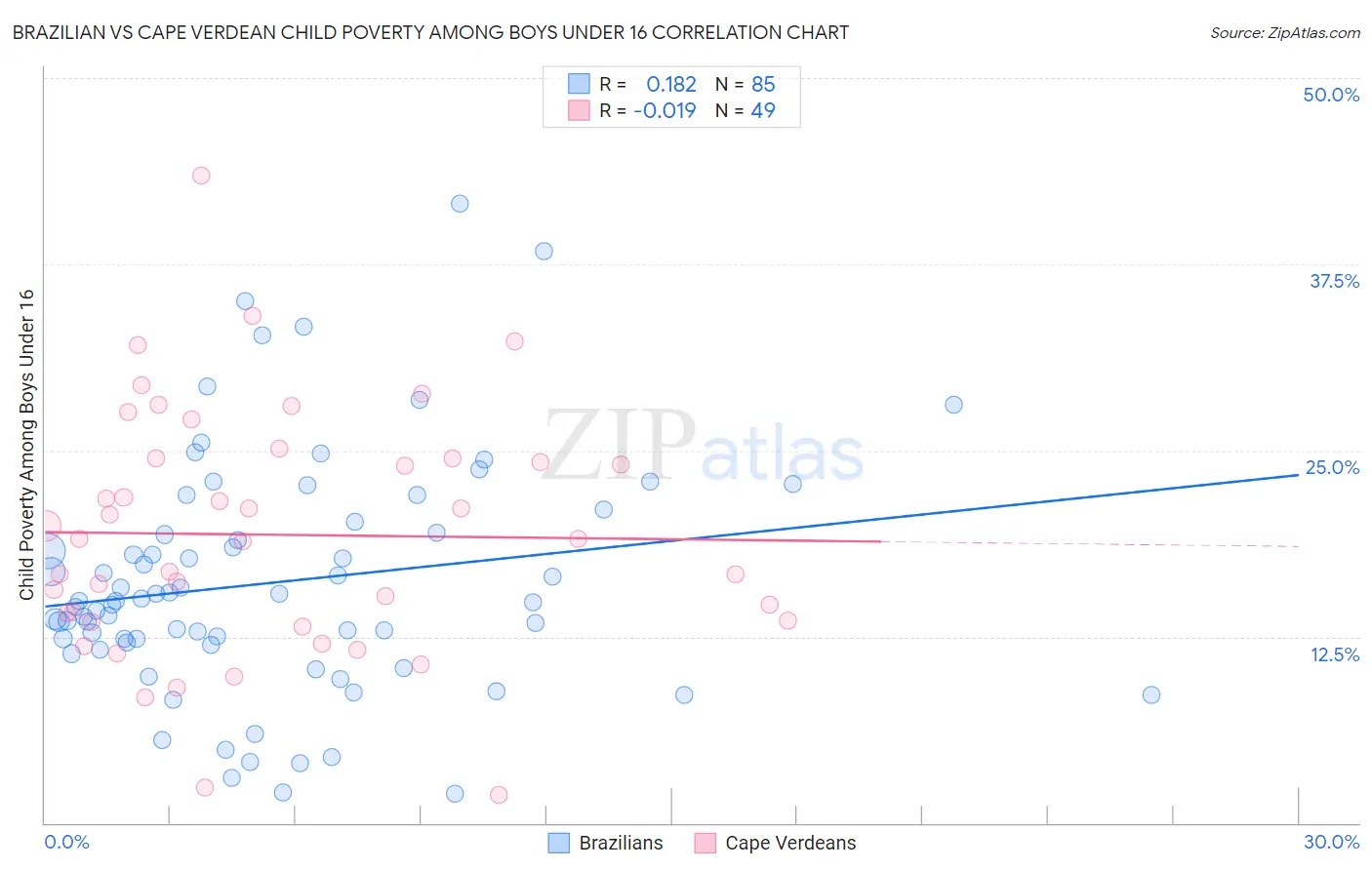Brazilian vs Cape Verdean Child Poverty Among Boys Under 16
COMPARE
Brazilian
Cape Verdean
Child Poverty Among Boys Under 16
Child Poverty Among Boys Under 16 Comparison
Brazilians
Cape Verdeans
15.8%
CHILD POVERTY AMONG BOYS UNDER 16
81.0/ 100
METRIC RATING
148th/ 347
METRIC RANK
18.7%
CHILD POVERTY AMONG BOYS UNDER 16
0.7/ 100
METRIC RATING
239th/ 347
METRIC RANK
Brazilian vs Cape Verdean Child Poverty Among Boys Under 16 Correlation Chart
The statistical analysis conducted on geographies consisting of 319,230,692 people shows a poor positive correlation between the proportion of Brazilians and poverty level among boys under the age of 16 in the United States with a correlation coefficient (R) of 0.182 and weighted average of 15.8%. Similarly, the statistical analysis conducted on geographies consisting of 106,786,125 people shows no correlation between the proportion of Cape Verdeans and poverty level among boys under the age of 16 in the United States with a correlation coefficient (R) of -0.019 and weighted average of 18.7%, a difference of 18.7%.

Child Poverty Among Boys Under 16 Correlation Summary
| Measurement | Brazilian | Cape Verdean |
| Minimum | 1.9% | 1.9% |
| Maximum | 41.6% | 43.4% |
| Range | 39.6% | 41.5% |
| Mean | 16.2% | 19.3% |
| Median | 14.9% | 19.1% |
| Interquartile 25% (IQ1) | 12.1% | 13.6% |
| Interquartile 75% (IQ3) | 19.9% | 24.5% |
| Interquartile Range (IQR) | 7.8% | 10.9% |
| Standard Deviation (Sample) | 7.9% | 8.2% |
| Standard Deviation (Population) | 7.9% | 8.1% |
Similar Demographics by Child Poverty Among Boys Under 16
Demographics Similar to Brazilians by Child Poverty Among Boys Under 16
In terms of child poverty among boys under 16, the demographic groups most similar to Brazilians are Slovak (15.8%, a difference of 0.14%), Immigrants from Jordan (15.8%, a difference of 0.15%), Venezuelan (15.7%, a difference of 0.20%), Puget Sound Salish (15.8%, a difference of 0.23%), and New Zealander (15.7%, a difference of 0.27%).
| Demographics | Rating | Rank | Child Poverty Among Boys Under 16 |
| Slavs | 84.5 /100 | #141 | Excellent 15.7% |
| Immigrants | Hungary | 84.1 /100 | #142 | Excellent 15.7% |
| Immigrants | Fiji | 83.6 /100 | #143 | Excellent 15.7% |
| Immigrants | Peru | 83.5 /100 | #144 | Excellent 15.7% |
| Samoans | 83.2 /100 | #145 | Excellent 15.7% |
| New Zealanders | 82.4 /100 | #146 | Excellent 15.7% |
| Venezuelans | 82.1 /100 | #147 | Excellent 15.7% |
| Brazilians | 81.0 /100 | #148 | Excellent 15.8% |
| Slovaks | 80.3 /100 | #149 | Excellent 15.8% |
| Immigrants | Jordan | 80.2 /100 | #150 | Excellent 15.8% |
| Puget Sound Salish | 79.8 /100 | #151 | Good 15.8% |
| Immigrants | Venezuela | 79.5 /100 | #152 | Good 15.8% |
| French | 78.7 /100 | #153 | Good 15.8% |
| Syrians | 77.5 /100 | #154 | Good 15.9% |
| French Canadians | 76.6 /100 | #155 | Good 15.9% |
Demographics Similar to Cape Verdeans by Child Poverty Among Boys Under 16
In terms of child poverty among boys under 16, the demographic groups most similar to Cape Verdeans are Immigrants from Laos (18.7%, a difference of 0.24%), Immigrants from Cuba (18.8%, a difference of 0.34%), Immigrants from Sudan (18.8%, a difference of 0.39%), Immigrants from Eritrea (18.6%, a difference of 0.45%), and Sudanese (18.6%, a difference of 0.61%).
| Demographics | Rating | Rank | Child Poverty Among Boys Under 16 |
| Marshallese | 1.3 /100 | #232 | Tragic 18.4% |
| Immigrants | Nigeria | 1.2 /100 | #233 | Tragic 18.4% |
| Nigerians | 1.1 /100 | #234 | Tragic 18.5% |
| Americans | 0.9 /100 | #235 | Tragic 18.6% |
| Sudanese | 0.9 /100 | #236 | Tragic 18.6% |
| Immigrants | Eritrea | 0.8 /100 | #237 | Tragic 18.6% |
| Immigrants | Laos | 0.8 /100 | #238 | Tragic 18.7% |
| Cape Verdeans | 0.7 /100 | #239 | Tragic 18.7% |
| Immigrants | Cuba | 0.6 /100 | #240 | Tragic 18.8% |
| Immigrants | Sudan | 0.6 /100 | #241 | Tragic 18.8% |
| Ghanaians | 0.5 /100 | #242 | Tragic 18.9% |
| Immigrants | Azores | 0.4 /100 | #243 | Tragic 18.9% |
| Immigrants | Middle Africa | 0.4 /100 | #244 | Tragic 18.9% |
| Cree | 0.4 /100 | #245 | Tragic 19.0% |
| Immigrants | Nicaragua | 0.4 /100 | #246 | Tragic 19.0% |